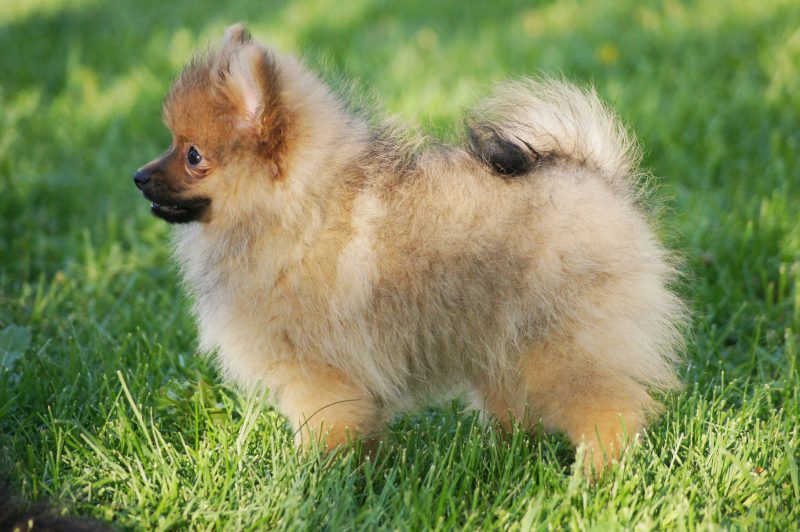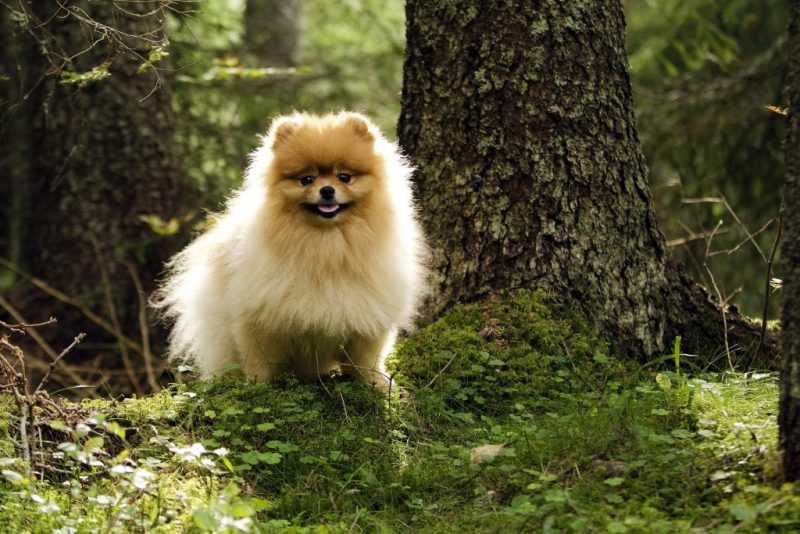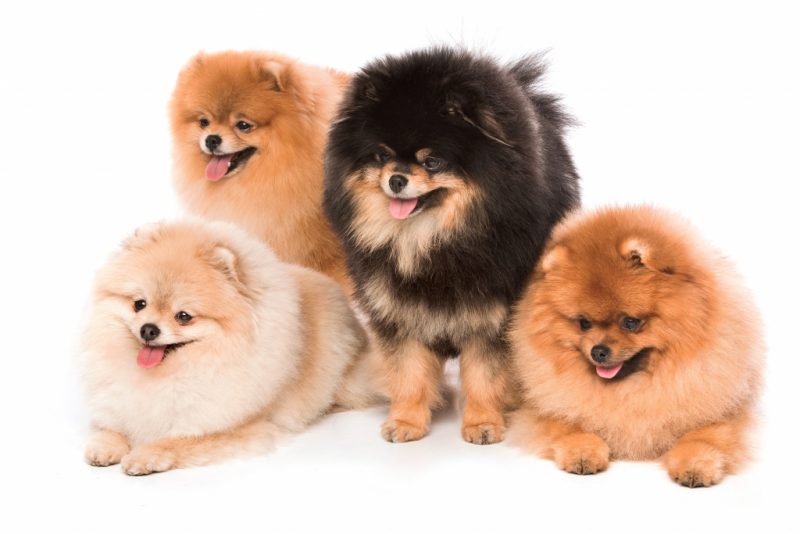Small German Spitz, or Kleinspitz, is considered one of the oldest breeds common in European territory. These dogs are small in size, but at the same time they are brave and courageous, always ready to defend the owner. Find out more about these wonderful pets.
Material Content:
Description of the breed and characteristics
Kleinspitz is a small-sized dog with a body whose shape is almost square.

The following breed standards are recognized:
- growth at the withers - from 23 to 29 cm;
- body weight - from 5 to 10 kg;
- wedge-shaped head, with a moderately pronounced transition from the frontal part to the muzzle;
- the muzzle is short, with a small round nose of black or brown color;
- ears set high and triangular, small in size, closely spaced;
- eyes are oval and small;
- the neck is short, with abundant hair resembling a mane;
- the chest is wide, the belly is lean;
- the back is strong and straight;
- paws are equal, parallel located.
The color of animals can be the most diverse: white, black, brown, red and other shades. A characteristic feature of Kleins is a long straight coat with a thick and dense undercoat. The life expectancy of animals is 14 to 15 years.
On a note. In England, America and Canada, small German and Pomeranian spitz dogs are isolated in separate breeds. In Russia and Germany, it is believed that orange is a dwarf variety of Kleinspitz.
History of breed origin
The birthplace of small Spitz is Germany.This breed was officially recognized in 1899 when it was registered under the international name Miniature Spitz. The population quickly won the love of dog breeders, not only in their homeland, but also in other European states.

However, disputes about the true origin of the breed have not subsided so far. The fact is that ancient images of animals similar to the Kleinspitz were found in many parts of the world. Such dogs were found in central Asia, Egypt, China and on the island of Madagascar.
There is an assumption that the distant ancestors of the Kleinspitz are wolves. This explains the ambiguous nature of the dog.
The purpose and nature of the dog
Kleins are considered decorative dogs; they are not adapted to hunting or security service. But these animals should not be perceived as a living soft toy, they are able to demonstrate their temper and are able to fend for themselves.

These dogs are active and funny; they love outdoor games and fun. They love their masters, but at the same time demand from them complete reciprocity. Kleinspitz adore children, such a puppy becomes a regular partner of the kids in games and pranks. To dogs of other breeds and other animals, Kleins are quite loyal.
Attention! Small German Spitz dogs suffer from a lack of attention from the owners and are very jealous. When acquiring such a pet, it is necessary to remember these qualities, otherwise the animal will suffer and, possibly, shall take revenge.
Kleinspitz puppy selection criteria
When choosing a puppy of a small German Spitz, you need to decide for what purposes a dog is acquired.

If the plans of the owners include participation in exhibitions or breeding, you need to pay attention to the following points:
- nursery reputation;
- the presence of the pedigree and other documents of the puppy;
- correspondence of the appearance of the selected individual to breed standards.
If the dog is considered just like a pet, just choose a healthy puppy.
To do this, you need to look at these nuances:
- The size of the animal. The puppy's dimensions should be age-appropriate, but choosing the largest one is also not worth it. It is important to remember that the weight of an adult dog of a small German Spitz ranges from 5 to 10 kg, depending on gender, and take an individual of medium size.
- Dog behavior. A healthy puppy will be mischievous, curious and cheerful. It is better not to get a shy doggie, hiding in a corner and avoiding contact with people.
- Appearance. The hair of a healthy Spitz is smooth, the eyes are shiny and clean, and the nose is moist and cool.
Tip. It’s better not to buy the dog from your hands, in the bird market or in the subway passage. Such an animal may well turn out to be unclean or sick.
Keeping and caring for a dog
Caring for Klein will not cause particular problems to the owner.

You will need to adhere to the following rules:
- Feed your pet 3-4 times a day as a puppy, and as an adult, reduce the number of meals to two.
- Give the pet food at the same hours, making sure that he eats everything without a trace.
- Supplement the diet with boiled meat, fish, cottage cheese, eggs and vegetables.
- In the absence of the ability to often take the animal out for a walk, provide a spitz with a tray.
- Bathe your pet as it gets dirty, listening to the hair with a hairdryer and combing it thoroughly.
- Monitor the condition of the teeth of the pet, as they are its weak point, and use special brushes and pastes.
- Regularly cut the dog's claws, grinding subsequently with a nail file. This should be done approximately every 2 months.
- Mow and comb the animal as necessary.
- Visit your veterinarian regularly.
It is important to remember that the small Spitz is very active, and not to restrict it in movement, but to play outdoor games with your pet on a walk.
How to train and raise a dog
It’s not difficult to train Kleins, they are smart, trained and remember teams very well.The main thing is to make the training varied so that the animal does not get bored. It is better to train the dog in a playful way.

Spitz can not be scolded and beaten, but at the same time he should feel that the main person in tandem. The animal reacts sharply to any unfair attitude, refusing to carry out commands and pretending not to understand them.
To start raising a dog you need immediately after its acquisition. It is very difficult to instill any good adult behavior skills.
Advantages and disadvantages of the breed
Like any breed, the small German Spitz has its advantages and disadvantages.

The positive features of these dogs include the following features:
- cheerful disposition and lack of aggression;
- cleanliness;
- high intelligence and learning ability;
- livability and tolerance for other animals;
- love for children.
The disadvantages of animals of this breed list such qualities:
- animals create a lot of noise, because they like to bark, and their voice is loud and loud;
- Spitzs are somewhat reckless and do not quite realize their size, barking and bullying large-breed dogs;
- when changing milk teeth, the pet will need the help of a veterinarian, and the indigenous ones will have to be regularly looked after;
- due to increased activity, the dog often receives various injuries;
- in excess of body weight in Spitz problems begin with the heart and blood vessels;
- to maintain an aesthetic appearance, you will need to carefully care for the dog's coat.
In light of the foregoing, we can conclude that all problems with a small German Spitz arise in cases where the owners pay little attention to his upbringing and incorrectly care for the pet.
How much is a small German Spitz
The cost of a puppy depends on what purpose the dog is needed for. If you purchase an elite copy, you will need to spend at least 45,000 - 50,000 rubles. Such an animal will meet all breed standards and have an impeccable pedigree.

You can buy a purebred Spitz, which will become a worthy participant in dog shows, for 35,000 - 45,000 rubles.
But if the pedigree is not of particular importance, but you just need a fun and provocative pet, 25,000 to 30,000 rubles will be enough to buy a puppy.
Despite some shortcomings, the small German Spitz will become a loyal and faithful friend, and if properly left, the owners will delight the owners with mischief and spontaneity for more than a decade.












